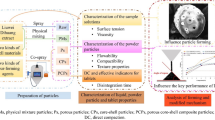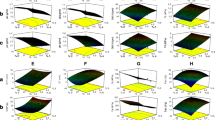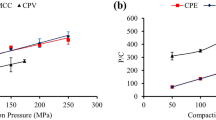Abstract
Core-shell composite particles (CPs) are the most preferred choice for direct compaction (DC), but their application in herbal tablets is limited. Hydroxypropyl methylcellulose (HPMC) and polyvinylpyrrolidone (PVP) are usually employed as the shell materials, but there are few, if any, researches exploring the different effects of HPMC and PVP on the properties of herbal CPs. In this study, the CPs containing HPMC (CP X-H) and CPs containing PVP (CP X-P) were prepared based on herbal powders (X). Their physical properties were characterized comprehensively. The differences in properties between CP X-H and CP X-P were explored, and their mechanism analysis was also performed profoundly. The results demonstrated that (i) CP X-H and CP X-P exhibited similar flowability; (ii) CP X-H generally exhibited better compactibility, larger particle size, and more uniform particle size distribution, and lower bulk density, tap density, and hygroscopicity than CP X-P; (iii) compared with the tablets produced with CP X-P, ones with CP X-H exhibited similar weight variation (%), lower friability, and longer disintegration time. The mechanism analysis manifested that the differences in physical properties between HPMC and PVP were the important and fundamental factors, which led to the differences in structure and surface morphology of particles, and in fundamental properties of CPs. These findings are beneficial to the development of herbal core-shell CPs for DC.




Similar content being viewed by others
Abbreviations
- Ad:
-
Adhesiveness
- AR:
-
Angle of repose
- AUC:
-
Area under curve
- AUTCC:
-
The area under tensile strength versus compaction force curve
- CF:
-
Compaction force
- ChP:
-
Chinese Pharmacopeia
- CI:
-
Carr’s index
- Co:
-
Cohesiveness
- CP:
-
Composite particle
- CP X-H:
-
Composite particles containing HPMC
- CP X-P:
-
Composite particles containing PVP
- CR:
-
Compaction ratio
- d(0.5):
-
Median particle size
- E SP :
-
Net energy per unit of quality
- F :
-
Breaking force
- f :
-
Equilibrium hygroscopic moisture content
- Ha:
-
Hardness
- HPMC/H:
-
Hydroxypropyl methylcellulose
- HR:
-
Hausner ratio
- k :
-
Moisture absorption constant
- MC:
-
Moisture content
- PL:
-
Percentage of net energy except friction energy
- PM:
-
Physical mixture
- PVP/P:
-
Polyvinylpyrrolidone
- P y :
-
Yield pressure
- ρ b :
-
Bulk density
- ρ t :
-
Tapped density
- ρ true :
-
True density
- Re:
-
Resilience
- R 2 :
-
Square of the correlation coefficient
- Sp:
-
Springiness
- Span:
-
Particle size distribution
- TS:
-
Tensile strength
- Un:
-
Uniformity
References
Wu G, Zhang W, Li H. Application of metabolomics for unveiling the therapeutic role of traditional Chinese medicine in metabolic diseases. J Ethnopharmacol. 2019;242:112057. https://doi.org/10.1016/j.jep.2019.112057.
Tanner T, Antikainen O, Pollet A, Raikkonen H, Ehlers H, Juppo A, et al. Predicting tablet tensile strength with a model derived from the gravitation-based high-velocity compaction analysis data. Int J Pharm. 2019;566:194–202. https://doi.org/10.1016/j.ijpharm.2019.05.024.
Li Z, Zhao L, Lin X, Shen L, Feng Y. Direct compaction: an update of materials, trouble-shooting, and application. Int J Pharm. 2017;529(1–2):543–56. https://doi.org/10.1016/j.ijpharm.2017.07.035.
Li Z, Zhou M, Wu F, Shen L, Lin X, Feng Y. Direct compaction properties of Zingiberis Rhizoma extracted powders coated with various shell materials: improvements and mechanism analysis. Int J Pharm. 2019;564:10–21. https://doi.org/10.1016/j.ijpharm.2019.04.021.
Baroutaji A, Lenihan S, Bryan K. Compaction analysis and optimisation of convex-faced pharmaceutical tablets using numerical techniques. Particuology. 2019;47:10–21. https://doi.org/10.1016/j.partic.2018.11.002.
Ren G, Clancy C, Tamer TM, Schaller B, Walker GM, Collins MN. Cinnamyl O-amine functionalized chitosan as a new excipient in direct compressed tablets with improved drug delivery. Int J Biol Macromol. 2019;141:936–46. https://doi.org/10.1016/j.ijbiomac.2019.08.265.
Li Z, Lin X, Shen L, Hong Y, Feng Y. Composite particles based on particle engineering for direct compaction. Int J Pharm. 2017;519(1–2):272–86. https://doi.org/10.1016/j.ijpharm.2017.01.030.
Li Z, Xian J, Wu F, Lin X, Shen L, Feng Y. Development of TCM-based composite particles for direct compaction by particle design. Powder Technol. 2018;338:481–92. https://doi.org/10.1016/j.powtec.2018.07.014.
Chen L, Ding X, He Z, Huang Z, Kunnath KT, Zheng K, et al. Surface engineered excipients: I. improved functional properties of fine grade microcrystalline cellulose. Int J Pharm. 2018;536(1):127–37. https://doi.org/10.1016/j.ijpharm.2017.11.060.
Chen L, He Z, Kunnath KT, Fan S, Wei Y, Ding X, et al. Surface engineered excipients: III. Facilitating direct compaction tableting of binary blends containing fine cohesive poorly-compactable APIs. Int J Pharm. 2019;557:354–65. https://doi.org/10.1016/j.ijpharm.2018.12.055.
Zhou Q, Shi L, Chattoraj S, Sun CC. Preparation and characterization of surface-engineered coarse microcrystalline cellulose through dry coating with silica nanoparticles. J Pharm Sci. 2012;101(11):4258–66. https://doi.org/10.1002/jps.23301.
Chattoraj S, Shi L, Sun CC. Profoundly improving flow properties of a cohesive cellulose powder by surface coating with nano-silica through comilling. J Pharm Sci. 2011;100(11):4943–52. https://doi.org/10.1002/jps.22677.
Mullarney MP, Beach LE, Dave RN, Langdon BA, Polizzi M, Blackwood DO. Applying dry powder coatings to pharmaceutical powders using a comil for improving powder flow and bulk density. Powder Technol. 2011;212(3):397–402. https://doi.org/10.1016/j.powtec.2011.06.008.
Ghoroi C, Gurumurthy L, McDaniel DJ, Jallo LJ, Dave RN. Multi-faceted characterization of pharmaceutical powders to discern the influence of surface modification. Powder Technol. 2013;236:63–74. https://doi.org/10.1016/j.powtec.2012.05.039.
Yang J, Sliva A, Banerjee A, Dave RN, Pfeffer R. Dry particle coating for improving the flowability of cohesive powders. Powder Technol. 2005;158(1–3):21–33. https://doi.org/10.1016/j.powtec.2005.04.032.
Vanhoorne V, Peeters E, Van Snick B, Remon JP, Vervaet C. Crystal coating via spray drying to improve powder tabletability. Eur J Pharm Biopharm. 2014;88(3):939–44. https://doi.org/10.1016/j.ejpb.2014.10.018.
Li J, Lin X, Wu F, Shen L, Wang Y, Feng Y. Application of the central composite design to optimize the calcium carbonate-HPMC co-processed excipient prepared by co-spray drying. RSC Adv. 2015;5(114):94105–14. https://doi.org/10.1039/c5ra15941e.
Taki H, Kobashi A, Ishida M, Otsuka M. Fundamental evaluation and optimization of porous spherical silica for developing functional fine particles via fluidized bed coating. Int J Pharm. 2019;571:118685. https://doi.org/10.1016/j.ijpharm.2019.118685.
Dong Q, Zhou M, Lin X, Shen L, Feng Y. Differences in fundamental and functional properties of HPMC co-processed fillers prepared by fluid-bed coating and spray drying. Eur J Pharm Sci. 2018;119:147–58. https://doi.org/10.1016/j.ejps.2018.04.001.
Zhou M, Wang Y, Wu F, Shen L, Lin X, Feng Y. Development on porous particles of Pueraria lobatae Radix for improving its compactibility and dissolution. RSC Adv. 2018;8(43):24250–60. https://doi.org/10.1039/c8ra04125c.
Wentzlaff M, Senz V, Seidlitz A. Evaluation of the suitability of a fluidized bed process for the coating of drug-eluting stents. Eur J Pharm Biopharm. 2019;139:85–92. https://doi.org/10.1016/j.ejpb.2019.03.013.
Lou H, Chung JI, Kiang YH, Xiao L-Y, Hageman MJ. The application of machine learning algorithms in understanding the effect of core/shell technique on improving powder compactibility. Int J Pharm. 2019;555:368–79. https://doi.org/10.1016/j.ijpharm.2018.11.039.
Qu L, Stewart PJ, Hapgood KP, Lakio S, Morton DAV, Zhou Q. Single-step coprocessing of cohesive powder via mechanical dry coating for direct tablet compression. J Pharm Sci. 2017;106(1):159–67. https://doi.org/10.1016/j.xphs.2016.07.017.
Li Z, Wu F, Zhao L, Lin X, Shen L, Feng Y. Evaluation of fundamental and functional properties of natural plant product powders for direct compaction based on multivariate statistical analysis. Adv Powder Technol. 2018;29(11):2881–94. https://doi.org/10.1016/j.apt.2018.08.009.
Huang S, Liu Y, Zhou Y, Li Q, Ren G, Jing Q, et al. Exploring the effect of PVP on the spherical agglomeration process and micromeritic properties of ascorbic acid. Powder Technol. 2019;342:929–37. https://doi.org/10.1016/j.powtec.2018.09.039.
Fell JT, Newton JM. Determination of tablet strength by the diametral-compression test. J Pharm Sci. 1970;59(5):688–91. https://doi.org/10.1002/jps.2600590523.
Al-Khattawi A, Koner J, Rue P, Kirby D, Perrie Y, Rajabi-Siahboomi A, et al. A pragmatic approach for engineering porous mannitol and mechanistic evaluation of particle performance. Eur J Pharm Biopharm. 2015;94:1–10. https://doi.org/10.1016/j.ejpb.2015.04.011.
Gao Y, Hong Y, Xian J, Lin X, Shen L, Zhang X, et al. A protocol for the classification of wet mass in extrusion-spheronization. Eur J Pharm Biopharm. 2013;85(3):996–1005. https://doi.org/10.1016/j.ejpb.2013.03.016.
Paul S, Taylor LJ, Murphy B, Krzyzaniak JF, Dawson N, Mullarney MP, et al. Powder properties and compaction parameters that influence punch sticking propensity of pharmaceuticals. Int J Pharm. 2017;521(1–2):374–83. https://doi.org/10.1016/j.ijpharm.2017.02.053.
Li Z, Luo J, Jiang Q, Zhao G, Liao Z, Liang X, et al. Roles of the main physical properties of the wet granulation product of hawthorn leaf extract mixtures in high shear granulation. J Food Process Preserv. 2017;41(4). https://doi.org/10.1111/jfpp.13047.
Martinez L, Peinado A, Liesum L, Betz G. Use of near-infrared spectroscopy to quantify drug content on a continuous blending process: influence of mass flow and rotation speed variations. Eur J Pharm Biopharm. 2013;84(3):606–15. https://doi.org/10.1016/j.ejpb.2013.01.016.
Yuan J, Shi L, Sun W-J, Chen J, Zhou Q, Sun CC. Enabling direct compression of formulated Danshen powder by surface engineering. Powder Technol. 2013;241:211–8. https://doi.org/10.1016/j.powtec.2013.03.010.
Sun CC. Decoding powder tabletability: roles of particle adhesion and plasticity. J Adhes Sci Technol. 2011;25(4–5):483–99. https://doi.org/10.1163/016942410x525678.
Fichtner F, Mahlin D, Welch K, Gaisford S, Alderborn G. Effect of surface energy on powder compactibility. Pharm Res. 2008;25(12):2750–9. https://doi.org/10.1007/s11095-008-9639-7.
Maghsoodi M, Taghizadeh O, Martin GR, Nokhodchi A. Particle design of naproxen-disintegrant agglomerates for direct compression by a crystallo-co-agglomeration technique. Int J Pharm. 2008;351(1–2):45–54. https://doi.org/10.1016/j.ijpharm.2007.09.033.
Khlibsuwan R, Pongjanyakul T. Particle agglomeration of chitosan-magnesium aluminum silicate nanocomposites for direct compression tablets. Int J Pharm. 2018;535(1–2):410–9. https://doi.org/10.1016/j.ijpharm.2017.11.030.
Santl M, Ilic I, Vrecer F, Baumgartner S. A compressibility and compactibility study of real tableting mixtures: the impact of wet and dry granulation versus a direct tableting mixture. Int J Pharm. 2011;414(1–2):131–9. https://doi.org/10.1016/j.ijpharm.2011.05.025.
Hibare S, Sivanathan R, Nadakatti S. Behaviour of soft granules under compression: effect of reactive and non-reactive nature of the binder on granule properties. Powder Technol. 2011;210(3):241–7. https://doi.org/10.1016/j.powtec.2011.03.024.
Funding
This work was funded by the National Natural Science Foundation of China (81973490), China; Natural Science Foundation of Shanghai (18ZR1439800, 18ZR1436600), China; China Postdoctoral Science Foundation (2019 M662278), China; Construction of Collaborative Innovation Center of Shanghai (2020-Sci&Tec-01-01-30), China; Science and Technology Research Project of Jiangxi Provincial Department of Education (GJJ190688), China; Three-year Action Plan for the Development of Traditional Chinese Medicine of Shanghai Municipal Health Planning Commission (ZY(2018-2020)-CCCX-2001-03), China; and Xinglin Young Scholar Program of Shanghai University of Traditional Chinese Medicine, China (A1-U17205010416); Postdoctoral Science Foundation of Jiangxi Province, China (2019KY42); Program of Jiangxi University of Traditional Chinese Medicine, China (2004/538200010402).
Author information
Authors and Affiliations
Corresponding authors
Additional information
Publisher’s Note
Springer Nature remains neutral with regard to jurisdictional claims in published maps and institutional affiliations.
Electronic Supplementary Material
ESM 1
(DOCX 52 kb)
Rights and permissions
About this article
Cite this article
Li, Z., Wu, F., Hong, Y. et al. The Fundamental and Functional Property Differences Between HPMC and PVP Co-Processed Herbal Particles Prepared by Fluid Bed Coating. AAPS PharmSciTech 21, 201 (2020). https://doi.org/10.1208/s12249-020-01739-4
Received:
Accepted:
Published:
DOI: https://doi.org/10.1208/s12249-020-01739-4




